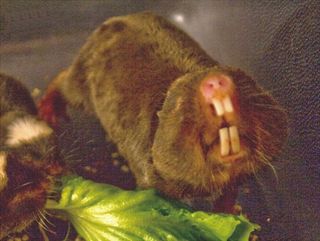
Original source: Cropped from: Seney ML, Kelly DA, Goldman BD, Šumbera R, Forger NG (2009) Social Structure Predicts Genital Morphology in African Mole-Rats. PLoS ONE 4(10): e7477. doi:10.1371/journal.pone.0007477.g001
Author: Sharry Goldman
Damara mole rat
Order : Rodentia
Suborder : Hystricognathi
Family : Bathyergidae
Species : Cryptomys damarensis
The Damara mole rat is listed as Least Concern. Does not qualify for a more at risk category. Widespread and abundant taxa are included in this category, on the IUCN Red List of Threatened Species
Namings for the Damara mole rat
A young / baby of a Damara mole rat is called a 'kitten, nestling, pinkie or pup'. The females are called 'doe' and males 'buck'. A Damara mole rat group is called a 'colony, horde, pack, plague or swarm'.Damara mole rat habitats
Caves, Caves and Subterranean Habitats (non-aquatic), Forest, Grassland, Subtropical / Tropical Dry forest and Subtropical / Tropical Dry GrasslandSome facts about the
Damaraland mole-rat
Adult weight : 0.18 kg (0.396 lbs)
Maximum longevity : 16 years
Female maturity :511 days
Gestation : 93 days
Weaning : 83 days
Litter size : 3
Litters per year : 1
Weight at birth : 0.009 kg (0.0198 lbs)
Body mass : 0.131 kg (0.2882 lbs)
Temperature : 34.85 °C (94.73 °F)
Facts about the Damara mole rat
Vitamin D metabolism in the Damara mole-rat is altered by exposure to sunlight yet mineral metabolism is unaffected -- Pitcher et al. (Full text)
The Damara mole-rat is a social creature and occurs in colonies of 16 to 41 members.
Vitamin D metabolism in the Damara mole-rat is altered by exposure to sunlight yet mineral metabolism is unaffected J Endocrinol 1994 143: 367-374. (Full text)
(1994) Vitamin D metabolism in the damara mole-rat is altered by exposure to sunlight yet mineral metabolism is unaffected.
More animals beginning with D
